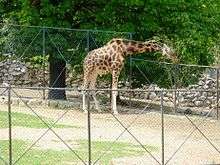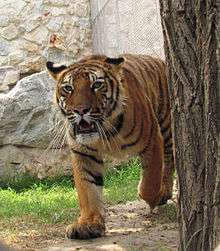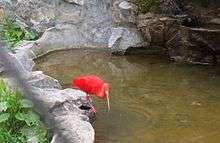Belgrade Zoo
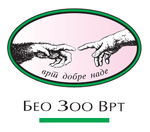 | |
 Entrance to the Belgrade Zoo | |
| Date opened | 12 July 1936 |
|---|---|
| Location | Kalemegdan Park, Belgrade, Ser |
| Coordinates | 44°49′33″N 20°27′12″E / 44.825832°N 20.453332°ECoordinates: 44°49′33″N 20°27′12″E / 44.825832°N 20.453332°E |
| Land area | 7 hectares (17 acres) |
| Number of animals | +1700 |
| Number of species | +150 |
| Major exhibits | African park, Australian park, South American park, petting zoo, terrarium |
| Website |
beozoovrt |
The Belgrade Good Hope garden (Serbian: Београдски врт добре наде / Beogradski vrt dobre nade) is a zoo located in Belgrade, Serbia. The zoo is situated at the very centre of the city, in Kalemegdan Park. Beo zoo vrt was founded in 1936 and is one of the oldest zoos in Europe.[1]
The zoo covers an area of about 7 hectares (17 acres),[2] and has about 1,700 animals representing amore than 150 different species. It holds domestic as well as exotic wild animals. 50 employees currently work in the zoo.
Its present look is contributed by many built facilities, new drinking-fountains, wooden Sculpture Gallery, the work of the sculptor Vuk Bojović and the nursery for young animals – Baby Zoo. For its 60th anniversary it was enriched with a monument dedicated to its once most interesting and most famous resident – Sammy the chimpanzee, the first of its kind ever in this Zoo. The future plans for the zoo are constructing a big exhibit for the birds of prey and a humboldt penguin habitat, wild griffon vulture population increasing project in Serbia, but also joining EAZA.
Animals

The Belgrade Zoo has 2000 animals and more than 270 species. The zoo has the biggest pride of white lions in the world, many tropical birds and birds of prey. Because of the meaning of the name of Belgrade ("white city"), Vuk Bojović decided to collect albino and white animals. Now the zoo has white tigers, lions, American bison, Arctic wolves, polar bears, albino wallabies and skunks. Some of the best-known animals are Muja (world's oldest alligator), Gabi (a dog which saved a guard from a jaguar) and Sammy chimpanzee who escaped from the zoo twice.The first white Bengal tiger arrived in 2006, aged 2 years. The male tiger is called Khan. Khan became the mascot of the Zoo. In February 2015, a Haemangiosarcoma tumor was discovered and removed from his left groin. Kahn died on 9 September 2015.
.jpg)
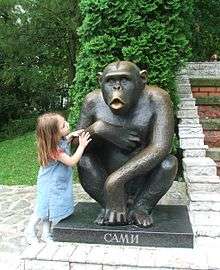
- mammals: African lion (white and ordinary), white tiger, Amur tiger, black leopard, cheetah, Arctic wolf, brown bear, polar bear, fennec fox, Balkan lynx, puma, jaguar, pine marten, European badger, honey badger, small-clawed otter, meerkat, yak, American bison, Barbary sheep, camel, muflon, Himalayan thar, red kangaroo, Parma wallaby, harbor seal, fur seal, Asian palm civet, red fox, fallow deer, grey wolf, persian leopard, serval, chimpanzee, Bactrian camel, orangutan, Brazilian tapir, ....
- birds: emu, ostrich, greater rhea, black swan, marabou stork, ground hornbill, golden eagle, horned owl, griffon vulture, Egyptian vulture, scarlet ibis, American flamingo, grey crowned crane, southern screamer, number of species of macaw and toucan, ...
- reptiles: Cuban crocodile, Burmese python, green anaconda, Nile monitor, Yemen chameleon, green iguana, ...
- Invertebrate: scorpion, tarantula, stick insect, leaf insect,...
- domestic animals: Pot-bellied pig, llama, guinea pig, pygmy goat, ferret, ...

The zoo has a lot of endangered species.
|
History
The Belgrade Zoological Garden was officially opened on 12 July 1936, by Belgrade mayor Vlada Ilić. The zoo was initially no larger than 3.5 hectares (8.6 acres), but was expanded to about 14 hectares.[2] During the Second World War, the zoo was bombed twice, in 1941 and 1944, heavily damaging the infrastructure and killing most of the animals. The zoo lost seven hectares of land.[2]
A 2-year-old who was holding on to the unprotected bars of the cage while looking in was bitten by a wolf in 1998.
Vuk Bojović became the director on 1 May 1986 until he died in 2014. He became very famous in the ex-Yugoslavia, especially in Serbia and Montenegro. He made numerous adjustments to improve the living conditions of the animals. The government, under the pressure of real estate groups tend tries to appropriate the places to build luxurious hotels, casinos and night clubs.[2] Present director is Gvozden Radenković. Today, even though the zoo covers only seven hectares, it has over 2000 animals, including over 270 animals species. It is not accredited by any international zoo association because of its small size relative to the number of animals.
In popular culture
There were several TV shows about the zoo:
- Priče iz zoo vrta (2009)
- Belgrade zoo (2011)
- S.I.U Belgrade (2011)
References
External links
| Wikimedia Commons has media related to Belgrade Zoo. |
